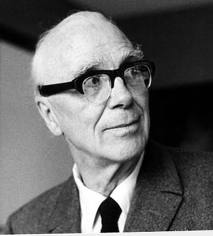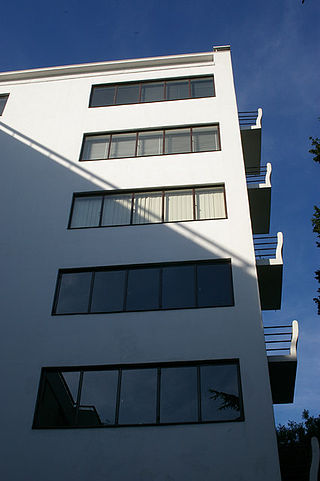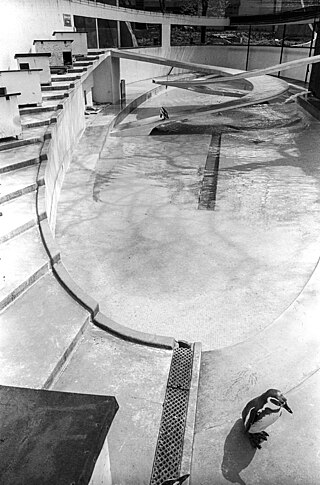
Clerkenwell is an area of central London, England.

Dudley Zoo & Castle is a 40-acre (16 ha) zoo within a 200-acre densely-wooded site located within the grounds of Dudley Castle in the town of Dudley, in the Black Country region of the West Midlands, England. The zoo opened to the public on 18 May 1937. It contains 12 modernist animal enclosures and other buildings designed by the architect Berthold Lubetkin and the Tecton Group. The zoo went into receivership in 1977 and was purchased by Dudley Metropolitan Borough Council. Dudley Zoo is now operated by Dudley and West Midlands Zoological Society, founded in 1978 and a registered charity.

Sir Denys Louis Lasdun, CH, CBE, RA was an eminent English architect, the son of Nathan Lasdun (1879–1920) and Julie. Probably his best known work is the Royal National Theatre, on London's South Bank of the Thames, which is a Grade II* listed building and one of the most notable examples of Brutalist design in the United Kingdom.
The year 1933 in architecture involved some significant architectural events and new buildings.
The year 1954 in architecture involved some significant events.

Berthold Romanovich Lubetkin was a Georgian-British architect who pioneered modernist design in Britain in the 1930s. His work includes the Highpoint housing complex, the Penguin Pool at London Zoo, Finsbury Health Centre and Spa Green Estate.

Sir Ove Nyquist Arup, CBE, MICE, MIStructE, FCIOB was an English engineer who founded Arup Group Limited, a multinational corporation offering engineering, design, planning, project management, and consulting services for building systems. Ove Arup is considered to be among the foremost architectural structural engineers of his time.

Highpoint I was the first of two apartment blocks erected in the 1930s on one of the highest points in London, England, in Highgate. The architectural design was by the Georgian-British architect Berthold Lubetkin, the structural design by the Anglo-Danish engineer Ove Arup and the construction by Kier.

The Tecton Group was a radical architectural group co-founded by Berthold Lubetkin, Francis Skinner, Denys Lasdun, Michael Dugdale, Anthony Chitty, Val Harding, Godfrey Samuel, and Lindsay Drake in 1932 and disbanded in 1939. The group was one of the leaders in bringing continental modernism to Britain.

The Finsbury Health Centre is in Clerkenwell, north London. It was built in 1935–38, designed by Berthold Lubetkin and the Tecton architecture practice. The design shares some of its materials and detailing with similar Lubetkin projects of the period, including the Priory Green, Spa Green and Hallfield Estates.

The Hallfield Estate, owned by Westminster City Council, is one of several modernist housing projects in Bayswater, London designed in the immediate postwar period by the Tecton architecture practice, led by Berthold Lubetkin. Following the dissolution of Tecton, the project was realised by Denys Lasdun and Lindsay Drake in the 1950s. Construction took place in two phases during 1951–55 and 1955–58.
Carl Ludwig Philipp Franck was a German-British architect who practiced in the United Kingdom from the 1930s to the 1960s. He was a member of the architectural practice Tecton from the late 1930s to its dissolution in 1948. A highly skilled draftsman, he provided detailed drawings of many of Tecton's most famous projects.

85–91 Genesta Road are four terraced houses in the Royal Borough of Greenwich, located south of Plumstead, north of Shooter's Hill near Plumstead Common, and are the United Kingdom's only modernist terrace built in the 1930s, designed by the architectural pioneer Berthold Lubetkin with A. V. Pilichowski. The houses were among the first attempts to redesign the traditional English house with the benefits of concrete construction. Completed in 1934, they are listed grade II*.
Peter Yates was a British born artist and architect. He was best known for his partnership with Gordon Ryder in the North of England architectural firm, Ryder and Yates.
Russell Thomas Francis Skinner was a British architect and the longest-serving member of Tecton, the architectural practice founded by Berthold Lubetkin in 1932 that pioneered the Modern Movement in Britain. As the historian John Allan recalls, ‘Skinner was Lubetkin's closest colleague, who shared and supported his charismatic partner's belief in modern architecture as an instrument of social progress’.

Spa Green Estate between Rosebery Avenue and St John St in Clerkenwell, London EC1, England, is the most complete post-war realisation of a 1930s radical plan for social regeneration through Modernist architecture. Conceived as public housing, it is now a mixed community of private owners and council tenants, run by a resident-elected management organization. In 1998 this work by the architect Berthold Lubetkin received a Grade II* listing for its architectural significance, and the major 2008 restoration brought back the original colour scheme, which recalls Lubetkin's contacts with Russian Constructivism.
Joldwynds is a modernist style house in Holmbury St Mary, Surrey, England, designed by architect Oliver Hill for Wilfred Greene, 1st Baron Greene. Completed in 1932, it is a Grade II listed building.

Blind Beggar and his Dog is a bronze statue of 1958, by the sculptor Elisabeth Frink, based on the famous ballad The Blind Beggar of Bethnal Green. It stands in the enclosed garden of Tate House, a residential development for the elderly on the Cranbrook Estate in the London district of Bethnal Green. It is a Grade II* listed structure.

The Penguin Pool at London Zoo, Regent's Park is a penguin enclosure designed in the International Modernist style by Berthold Lubetkin and the Tecton Group. Constructed in 1934, Historic England describe it as "a key symbol of British Modern Movement architecture". The pool housed the zoo's collection of penguins for 70 years. Changing attitudes to keeping animals in captivity, and concerns regarding the suitability of the structure for penguin well-being, saw the pool's closure in 2004 and its subsequent replacement by Penguin Beach. After a period of non-use, during which Lubetkin's daughter called for the structure to be "blown to smithereens", the pool was converted into a water feature. It is a Grade I listed building.

The Gorilla House is a building at London Zoo, on a site between Regent's Canal and the Outer Circle of Regent's Park. Built in 1932–33, it was designed by the Modernist architect Berthold Lubetkin, with civil engineering assistance from Ove Arup, in the International Style. It was the first substantial building completed to a design by Lubetkin's firm, Tecton Group, and the firm's first building at London Zoo. It was designated as a Grade I listed building in 1970.

















